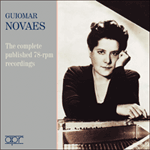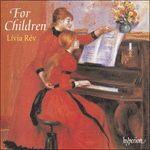
Welcome to Hyperion Records, a British classical label devoted to presenting high-quality recordings of music of all styles and from all periods from the twelfth century to the twenty-first.
Hyperion offers both CDs, and downloads in a number of formats. The site is also available in several languages.
Please use the dropdown buttons to set your preferred options, or use the checkbox to accept the defaults.

The first suite (1918) is dedicated to Lucilia Villa-Lobos, the composer’s wife whom he had married in 1912. There are strong elements of polytonality—which Villa-Lobos concurrently developed after Milhaud’s lead—in that in various places in the music the right hand plays on the white keys, with the left hand on the black, and the influence of Stravinsky’s Petrushka may not be far away.
Branquinha: The first suite opens with a delicate texture, high on the keyboard, which soon reveals a lyrical theme that seems to contradict the Très animé et gai marking. The form is a simple ABAB with a brief vivo codetta.
Moreninha: This lively little piece, whose dynamic is always half-stated, is akin to a moto perpetuo and is based upon a favourite Villa-Lobos tonality of C sharp. The simplicity of the ABA structure conceals some brilliant and original keyboard writing, and the final chord thwarts all expectations.
Caboclinha: A simple 3+3+2 accompaniment figure sustains this beautifully atmospheric, authentically Brazilian—in its evocation of folksong—piece, with its almost sensuous dance-like melodic fragments creating a crescendo-diminuendo structure.
Mulatinha: The mulatto figure is almost literally a colourful mixture of ideas, mainly pentatonic, but a built-in accelerando does not hide the underlying polytonal basis.
Negrinha: A brilliant toccata-like study similarly contrasts A flat major and C major.
A Pobrezinha: Here our sympathies are invoked, Lentement et mélancolique, for this waif, her soft yet uncertain B–C sharp–E chords supporting rather than troubling her.
O Polichinelo: This was the last music Arthur Rubinstein played in public—his final encore. It was a piece he played—and altered slightly—often, and it recalls, more than any other item in this Suite, Petrushka, three movements from which Stravinsky arranged and dedicated to the virtuoso in 1921, despite one of them being virtually unplayable as written. Villa-Lobos’s ‘Punch’ is playable, and became one of the most famous of all the Brazilian’s shorter works.
A Bruxa: This is a very different piece. The uncertain, troubled atmosphere is all-pervasive, and the three sections—Lente, Preste, Lente—are not wholly organic, except for the consistency of Villa-Lobos’s favourite key of C sharp.
from notes by Robert Matthew-Walker © 2000
Dédiée à Lucilia Villa-Lobos que le compositeur avait épousée en 1912, la première suite (1918) dévoile de substantiels éléments polytonaux—Villa-Lobos s’était attaché à développer la polytonalité en même temps que Milhaud, après que ce dernier eut ouvert la voie. Effectivement, à plusieurs reprise la main droite joue les touches blanches tandis que la main gauche se concentre sur les noires. De même l’influence du Stravinsky de Petrouchka ne semble jamais être très loin.
Branquinha—A boneca de louça («Petite blanche—La poupée de biscuit»). La première suite s’ouvre sur une texture délicate dans le registre aigu du clavier qui révèle rapidement un thème lyrique semblant contredire l’indication «Très animé et gai». La coupe est un simple ABAB couronné par une brève codetta notée «vivo».
Moreninha—A boneca de massa («Petite brune—La poupée de papier mâché»). Cette petite pièce pleine de vie dont les nuances sont toujours en demi-teinte s’évertue comme un moto perpetuo. Elle s’inscrit dans une des tonalités préférées de Villa-Lobos, do dièse. La simplicité de sa structure ABA cache une écriture pianistique originale et brillante. L’accord final prend le contre-pied de toutes les attentes.
Caboclinha—A boneca de barro («Petite indigène du Brésil—La poupée en argile»). Un simple motif d’accompagnement en 3+3+2 pare cette œuvre d’une atmosphère magnifique et authentiquement brésilienne—dans son évocation de mélodie folklorique—où des fragments mélodiques d’une sensualité proche de la danse créent une structure en crescendo- diminuendo.
Mulatinha—A boneca de borracha («Petite mulâtresse—La poupée en caoutchouc»). Le motif de la mulâtresse est presque littéralement un mélange coloré d’idées, pentatoniques principalement, mais l’accelerando ne parvient à cacher le fond polytonal de l’œuvre.
Negrinha—A boneca de páo («Petite négresse—La poupée en bois»). Une étude brillante à la manière d’une toccata qui contraste la bémol majeur et do majeur.
A Pobrezinha—A boneca de trapo («Petite pauvre—La poupée de chiffons»). Voici que sont évoqués nos bons sentiments, Lentement et mélancolique, pour cette enfant des rues. Les doux accords et pourtant incertains de si–do dièse–mi semblent la réconforter et plutôt que de la déconcerter.
O Polichinelo («Le polichinelle»). Il s’agit de la dernière œuvre que Rubinstein donna en concert—son dernier bis. Cette pièce qu’il jouait souvent et altérait un peu, rappelle plus que toute autre de cette suite, la transcription de Petrouchka que Stravinsky réalisa et dédia au virtuose en 1921, même si l’une des trois scènes demeure pourtant virtuellement injouable. Le «polichinelle» de Villa-Lobos est jouable et devint une des courtes œuvres les plus célèbres du Brésilien.
A Bruxa—A boneca de panno («Sorcière—La poupée de drap»). Très différente de ce qu’on a pu entendre jusqu’à présent, cette œuvre à l’atmosphère incertaine, troublée et envahissante s’articule en trois sections—Lente, Preste, Lente. Elles ne sont pas entièrement organiques, à l’exception de la tonalité préférée de Villa-Lobos, do dièse qui s’impose.
extrait des notes rédigées par Robert Matthew-Walker © 2000
Français: Isabelle Battioni
Die erste Suite (1918) ist Villa-Lobos’ Frau Lucilia gewidmet, die er 1912 geheiratet hatte. Sie enthält insofern starke Elemente polytonaler Technik—die Villa-Lobos nach Milhauds Anregung gleichzeitig mit ihm entwickelte—, als die rechte Hand an verschiedenen Stellen auf den weißen Tasten spielt, die linke auf den schwarzen; der Einfluß von Strawinskis Petruschka dürfte nicht allzu fern liegen.
Branquinha—A boneca de louça („Weißes Porzellanpüppchen“). Die erste Suite beginnt mit einem zarten Klanggebilde hoch auf der Tastatur, das bald ein lyrisches Thema offenlegt, das im Widerspruch zur Bezeichnung Très animé et gai zu stehen scheint. Die Form ist ein schlichtes A–B–A–B mit einer kurzen, vivo bezeichneten Schlußgruppe.
Moreninha—A boneca de massa („Brünettes Pappmachè-Püppchen“). Dieses lebhafte kleine Stück, dessen Dynamik stets nur halb zum Ausdruck kommt, gleicht einem moto perpetuo und beruht auf der bei Villa-Lobos beliebten Tonalität Cis. Die Schlichtheit der A–B–A-Struktur kaschiert die teils brillante und originelle Klavierführung, und der Schlußakkord widerspricht allen Erwartungen.
Caboclinha—A boneca de barro („Mestizen-Tonpüppchen“). Eine einfache 3+3+2-Begleitfigur trägt dieses wunderbar atmosphärische, in seiner Beschwörung eines Volkslieds authentisch brasilianische Stück, dessen beinahe sinnliche, tänzerische Melodiefragmente eine Crescendo-Diminuendo-Struktur schaffen.
Mulatinha—A boneca de borracha („Mulatten-Gummipüppchen“). Die Mulattenfigur ist—quasi im Wortsinne—eine farbenfrohe Mischung aus vorwiegend pentatonischen Ideen, auch wenn ein eingebautes Accelerando die zugrunde liegende polytonale Basis nicht verbirgt.
Negrinha—A boneca de páo („Schwarzes Holzpüppchen“). Eine brillante Etüde nach Art einer Toccata stellt in ähnlicher Weise kontrastierend As-Dur und C-Dur gegeneinander.
A Pobrezinha—A boneca de trapo („Das arme Flickenpüppchen“). Hier werden lentement et mélancolique unsere Sympathien für die Verlassene geweckt; ihre leisen, unsicheren B/Cis/E-Akkorde stützen sie eher, als daß sie sie beunruhigten.
O Polichinelo („Kasper“). Dies war die letzte Musik, die Arthur Rubinstein vor Publikum spielte—seine abschließende Zugabe. Er spielte dieses Stück oft (und änderte es dabei leicht ab), und es erinnert eindeutiger als irgendein anderer Teil dieser Suite an Petruschka, aus dem Strawinski 1921 drei Sätze bearbeitete und dem Virtuosen widmete, obwohl einer davon in der niedergeschriebenen Form fast unspielbar war. Villa-Lobos’ O Polichinelo ist ausgesprochen spielbar und wurde zu einem der berühmtesten kürzeren Werke des Brasilianers.
A Bruxa—A boneca de panno („Die Hexen-Stoffpuppe“). Dies ist ein ganz anders geartetes Stück. Die ungewisse, beunruhigende Atmosphäre ist allgegenwärtig, und die drei Abschnitte Lente, Preste, Lente sind abgesehen vom konsequenten Einsatz von Villa-Lobos’ Lieblingstonart Cis nicht ganz organisch gefügt.
aus dem Begleittext von Robert Matthew-Walker © 2000
Deutsch: Anne Steeb/Bernd Müller
 Guiomar Novaes - The complete published 78-rpm recordings Guiomar Novaes - The complete published 78-rpm recordingsThis double album draws together for the first time all the published 78-rpm recordings made by Brazilian Guiomar Novaes. She is better known today for her later recordings from the LP era, but these early miniatures, recorded between 1919 and 194 ...» More |
 For Children For Children‘An adventurous and well-devised recital, as well played as it is recorded’ (Gramophone) ‘A wholly delectable recital, and not just for children either. First class. Highly recommended for late-night listening’ (The Penguin Guide to Compac ...» More |

